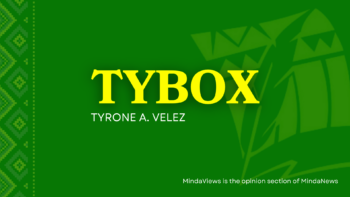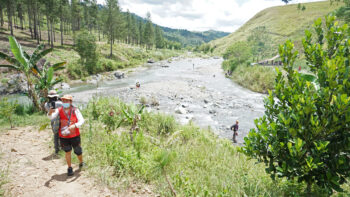Part 2: Opportune Moment (Continued from June 2)
GENERAL SANTOS CITY, June 27, 2016 – Philippine Daily Inquirer Columnist Amando Doronila sees the Duterte-media tiff as “an unprecedented test of wills between the presidency and the media, a ferocity not experienced by any incoming administration in the history of the adversarial relationship between the two social institutions. The conflict has entered an impasse from which none of the protagonists appears to be backing off.”
Perhaps, that also is how the President and media see their standoff. Media may appear browbeaten but they have not thrown in the towel. They will not. They will play ball as fawning ally, critical collaborator or adversarial tormentor. They know how government and media need each other for a common end – the good of the nation, whether assumed with sincerity or pretension.
Hence, we see the tiff differently – a test of sincerity and an opportune moment for both Duterte and media leaders to see the challenges to rid private and state media of all forms of corruption and wrong to be truly relevant to their common end.
That Duterte has classified and described three types of journalists — regularly employed in media establishments and free lancing — NUJP and NPC have acknowledged. No journalist or any other media organization can deny the truth. But Duterte seems not to see the fourth type – the government-employed journalists paid with the people’s money, the government media. The Palace media headed by a secretary has television, radio and print sections. Executive Department offices down to the local level have PROs.
How do journalists in private practice and the government-employed differ?
The first, especially the corrupt, flirt with death in the practice of their profession; even the upright “crusaders” risk their lives in exposing the truth. Duterte has likened them to soldiers. The second are regularly paid and safe – those in the Palace media, handsomely remunerated.
What are the challenges?
To Private Media
It is not enough that NUJP and NPC (the Philippine Press Institute and the Publishers Association of the Philippines, Inc. have been unheard of) acknowledge the corruption and deplorable conditions in the Philippine media industry in their confrontation with Duterte. They should also admit their helplessness to rid their own houses of the mess dating to decades back then start the cleansing in earnest.
To shorten a long litany of mess: (1) stiff and unfair competition for ads and patronage; (2) indecent pay of reporters, correspondents and staff, especially among provincial and community press and radio; and (3) whether decently or indecently paid, many journalists augment their income by prostrating themselves before political gods and vested interest or by engaging in ac-dc (attack-and-collect or defend-and-collect) type of extortion in violation of their code of ethics.
Invoking freedom of the press, expression and information, despite their tolerance of media corruption and deplorable conditions in media industry, NUJP and NPC together with international press watchdogs, always extolled the martyrdom of slain journalists and blame government for failing to give them justice. Certainly, killing any corrupt journalist may be unjust; but, so is the tolerance of the environment of corruption.
One incident often cited is the infamous November 23, 2009 Maguindanao massacre. This is a most massive and sensitive case – 32 journalists slain. The victims and their families deserve justice. That justice has been denied of them going into the seventh year is due to our justice system that is prone to denial. But justice and blaming government will not stop media killing. It is probing beyond the sensitivity of the case that will help. The same can be said of all other media killings of lesser magnitude and sensitiveness.
How the massacre happened as published by local and national media elicit questions that are embarrassing to the media institution but are vital to the understanding and cleansing of the mess in Philippine media industry. Like all other media killings, the 32 have been memorialized as martyrs of freedom of the press dying in line of duty.
The journalists had been invited to cover the filing of the certificate of candidacy of Buluan, Maguindanao Vice Mayor Esmael Mangudadatu in Shariff Aguak, the provincial capital, for governor of Maguindanao. Doing so at the behest of Mangudadatu, they also defied the warning of Gov. Andal Ampatuan that Mangudadatu would be chopped into pieces should he oppose the candidacy of the governor’s son, Datu Unsay Mayor Andal Ampatuan Jr. They put themselves in mortal danger.
Was the filing of Mangudadatu’s certificate of candidacy so great an event as to merit coverage by that number of journalists? Their leaders who had tried coordinating with the military and the police but were denied security detail knew the risk. Why did they have to proceed? For what were they pawning their lives in the political chessboard?
The challenge to NUJP, NPC and all other media organizations including the local press clubs is to probe thoroughly the roots of hundreds of media killing including the Maguindanao massacre. This is vital to cleansing the mess in their house and stop media killing. In other words, to avoid fire don’t play with it. Look into yourself before blaming all on presidents and the government
To Government Media
National and local governments employ publicists and PROs; in some offices, certain officials are designated as spokespersons. The military has civic relations officers besides spokespersons. They foster the good image of their offices through good public relations.
Government media conveniently facilitate the flow of information from the government to the people and vice versa – either directly, government to people or people to government; or indirectly, people to private media to government or government to private media to people.
Public information offices are channels of information from the people to government policy and decision makers concerning their needs; and from government to the people concerning policies, programs and project implementations. Often, government and people use private media as go-between.
What’s wrong about that? Obviously, none. That is genuine democracy.
Government media people don’t extort money; they don’t tarnish good reputation of others. Routinely, they tell the people in press releases and radio-television programs, what the government wants to do and is doing for their welfare. When some people complain, they explain; they defend their offices and officials – the chief executives, the policy and decision makers and the project implementors – when criticized.
Can government media be accused of corruption? No, not the corruption attributed to private media. But corruption has other forms and faces.
Journalists in the private media have been criticized for engaging in “envelopmental journalism”. They received money in envelops, regularly or occasionally, from the offices of the president, the governor or the mayor through the PROs of these offices in exchange for publicity. We don’t know if this is still being practiced. But, certainly, envelopmental journalism was corruption on both ends.
In late 1980s, as editor of Cotabato City’s top newspaper, we had a chance to go over the plantilla of the Sangguniang Panglunsod (City Council). In there was the name of one of the reporters of a city paper under the item “special assistant”. That reporter had the City Council for his regular beat. Curiously, how many reporters having government offices as their regular beat are doubling as government media personnel on regular payroll or some form of honoraria?
The instances cited above may now be practices of the past. They may no longer be challenges to President Duterte and his administration. However, if he really wants media cleansed of wrong, besides corruption, and truly be bearers of truth, there is still much cleansing to do starting from the Palace.
The Palace media, as we see it, consists of the presidential spokespersons, a news agency (PNA), an information agency (PIA) and radio and television networks. Collectively, with multi-billion-peso budgets they inform the nation of what the government is doing, of the state of the nation, through their own networks and private media. The television networks have programs educating people on how to improve their lives and develop their communities elucidated with successful government projects as models.
They only tell the “good”, never the “faults” – the failures, the omissions, etc. Why do the people have to be told of what good the government has done for them? They must know if they are really enjoying the “good”. So those, greater in number, who live in deplorable conditions are disenchanted. This is akin to brainwashing the nation.
Telling half-truth, especially the lesser half, foments discontentment. This is not corruption but it is wrong.
One challenge to Duterte is how to make the Palace media not to tell half-truth about the state of the nation. Another is his how to encourage the Palace media to tell the President what’s wrong with his government and the nation. And more: Palace media, especially the presidential spokespersons, must not be spin masters – making the wrong look good, the lie as truth – in defending the President and his government from critics.
May President Duterte be the first president not to resent adverse criticism from private media and not accuse them of negativism. Then the Duterte administration may become the first not to be appraised negatively by the succeeding administration. The cycle has ever been this: The sitting president portrays his administration as a heaven; his successor condemns it to hell.
Riding the Boycott
It is hoped that President Duterte reconsiders his declaration to boycott media until the end of his term. He and the nation have more to gain if he talks with the critical media and much more to lose if he does not. The more he would lose if he refuses interviews and press conferences with international media.
Even if he sticks to his declaration, journalists can interview the cabinet secretaries and other high government officials. Even if he prohibits his cabinet secretaries and other high government officials from giving media interviews that will not stop journalists from reporting and criticizing what’s going on in the Duterte government; that will not stop them from going to the field to get first-hand information. They can ride the boycott.
Instead of interviewing him, reporters, he said, can get news feed from PTV 4 – understandably, from other government televisions and radio, the Philippine News Agency and the Philippine Information Agency. These have long been minor news sources for private media. National newspapers, televisions and radios have their own networks to gather news.
Journalists true to their profession very highly value their pride. They always prefer first-hand to second-hand information. They will take PTV-4 news feed as poor substitute for an interview with the President.
Press conferences and interviews are opportune moments for the President to know from journalists what’s right and what’s wrong in his government. Will Duterte deny himself the opportunity?







